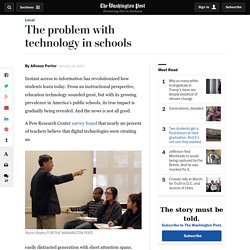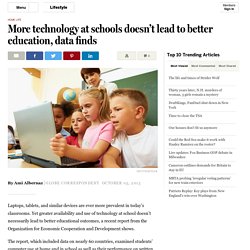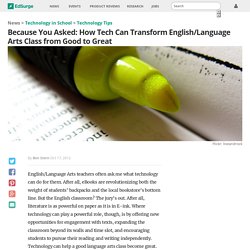

Amy Stewart
Putting More Technology In Schools May Not Make Kids Smarter: OECD Report. Educational Technology. The problem with technology in schools. Instant access to information has revolutionized how students learn today.

From an instructional perspective, education technology sounded great, but with its growing prevalence in America’s public schools, its true impact is gradually being revealed. And the news is not all good. A Pew Research Center survey found that nearly 90 percent of teachers believe that digital technologies were creating an (Norm Shafer/FOR THE WASHINGTON POST) easily distracted generation with short attention spans.
Between class periods, the halls of American high schools resemble a traffic jam on the interstate as they glare hypnotically into a screen. Yet, this behavior does not always stop at the classroom door — and that has also become another major issue. Teachers are now forced to perform the “put that away, unplug that, please log off” dance every class period, resulting in a waste of valuable instructional time. More technology at schools doesn’t lead to better education, data finds. Laptops, tablets, and similar devices are ever more prevalent in today’s classrooms.

Yet greater availability and use of technology at school doesn’t necessarily lead to better educational outcomes, a recent report from the Organization for Economic Cooperation and Development shows. The report, which included data on nearly 60 countries, examined students’ computer use at home and in school as well as their performance on written and digital tests. It found that while students who use computers moderately at school have somewhat better outcomes than those who don’t use them at all, those who use them very frequently tend to do significantly worse, even after accounting for students’ and schools’ socioeconomic status. Continue reading below The findings come at a time when adoption of technology in classrooms is steadily growing. Parents can also advocate for thoughtful approaches to implementing technology in classrooms, she added.
Ami Albernaz can be reached at ami.albernaz@gmail.com. The New School Library. Without question, the Internet has changed the way we think and learn, and will continue to do so as our technology evolves. In particular, the ability to access enormous amounts of information at any time from almost any place is forcing schools to redefine the idea of a classroom and the way we approach teaching. It is also reshaping the notion of school library services — what libraries look like and how they and librarians best serve schools. Increasingly, we hear the questions: “Are libraries necessary today? Isn’t everything on the Internet? Can’t we use the library space for better purposes?”
Clearly, a popular impression out there is that the plentiful free information on the open Internet will answer all academic needs. School libraries shelve tradition to create new learning spaces. What happens to school libraries when students find it more natural to turn to a computer screen than a book?

That is the question facing schools around the world as they struggle to keep up with the digital revolution while fostering a love of literature. Many have found creative answers, developing spaces that allow children to make discoveries, put technology to imaginative use, learn, perform, and relax – as well as to read. In the process, libraries have often come to be the school’s focal point. This was the idea behind the new library at Dixons Allerton Academy in Bradford built centrally over the entrance and linking the primary and secondary schools on the campus.
How to Teach with Technology: Language Arts. Check out these tips from students and educators for high tech teaching: Video Dialogues "I think students would retain a lot more information if they made a video about the person they're studying or created an instant message dialogue in which they imagine a fictional conversation between characters, as opposed to just taking a test or writing an essay.

Because You Asked: How Tech Can Transform English/Language Arts Class from Good to Great. English/Language Arts teachers often ask me what technology can do for them.

After all, eBooks are revolutionizing both the weight of students’ backpacks and the local bookstore’s bottom line. But the English classroom? The jury’s out. After all, literature is as powerful on paper as it is in E-ink. Where technology can play a powerful role, though, is by offering new opportunities for engagement with texts, expanding the classroom beyond its walls and time slot, and encouraging students to pursue their reading and writing independently.
8 Technologies That Will Shape Future Classrooms. 12 Easy Ways to Use Technology in the Classroom, Even for Technophobic Teachers. Everyone wants teachers to use technology in the classroom. But you're busy -- meeting standards, prepping students for tests -- and maybe you’re not too fond of computers, anyway. Never fear – there are easy ways to bring your classroom up-to-date, technologically. Why Technology Alone Won't Fix Schools. For about a month in the spring of 2013, I spent my mornings at Lakeside School, a private school in Seattle whose students are the scions of the Pacific Northwest elite.

The beautiful red-brick campus looks like an Ivy League college and costs almost as much to attend. The school boasts Bill Gates among its alumni, and its students come from the families of Amazon and Microsoft executives. Unsurprisingly, there is no dearth of technology: Teachers post assignments on the school’s intranet; classes communicate by email; and every student carries a laptop (required) and a smartphone (not).